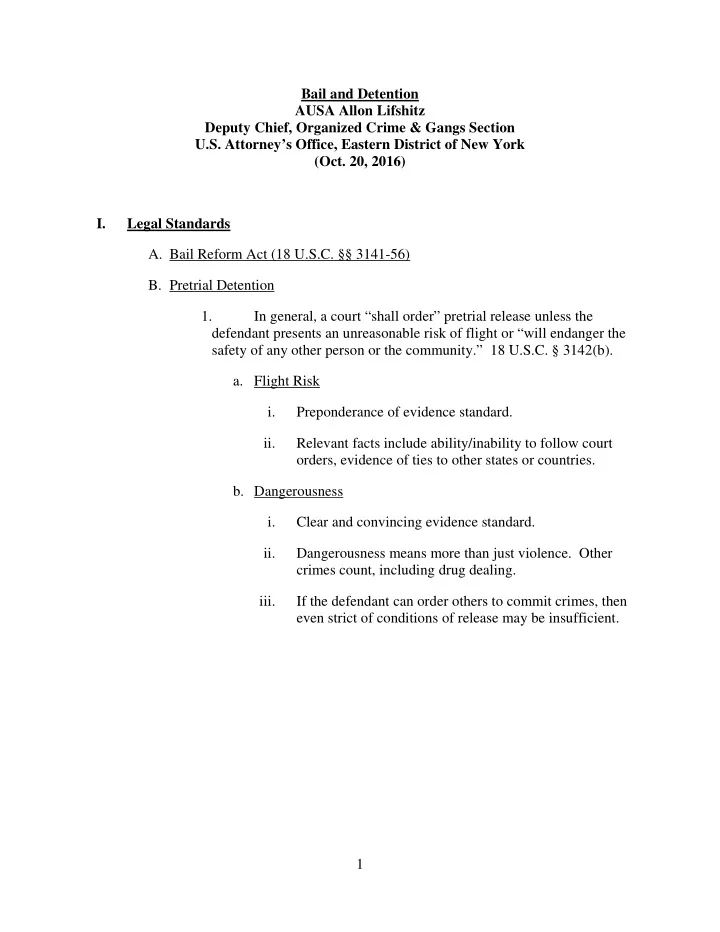

Bail and Detention AUSA Allon Lifshitz Deputy Chief, Organized Crime & Gangs Section U.S. Attorney’s Office, Eastern District of New York (Oct. 20, 2016) I. Legal Standards A. Bail Reform Act (18 U.S.C. §§ 3141-56) B. Pretrial Detention 1. In general, a court “shall order” pretrial release unless the defendant presents an unreasonable risk of flight or “will endanger the safety of any other person or the community.” 18 U.S.C. § 3142(b). a. Flight Risk i. Preponderance of evidence standard. ii. Relevant facts include ability/inability to follow court orders, evidence of ties to other states or countries. b. Dangerousness i. Clear and convincing evidence standard. ii. Dangerousness means more than just violence. Other crimes count, including drug dealing. iii. If the defendant can order others to commit crimes, then even strict of conditions of release may be insufficient. 1
c. Factors for Flight and Dangerousness (18 U.S.C. § 3142(g)) i. “the nature and circumstances of the offense charged, including whether the offense is a crime of violence . . . or involves a . . . firearm . . .”; ii. “the weight of the evidence against the person”; iii. “the history and characteristics of the person, including . . . the person’s character, . . . past conduct, . . . [and] criminal history, and record concerning appearance at court proceedings”; and iv. “the nature and seriousness of the danger to any person or the community that would be posed by the person's release.” 2. Obstruction of Justice / Witness Tampering a. This is another basis for detention. 18 U.S.C. § 3142(f)(2)(B). 3. Presumption Cases a. Drug Cases: A presumption of both flight and dangerousness arises if there is probable cause to believe the defendant committed a drug offense carrying a maximum sentence of ten years or more. 18 U.S.C. § 3142(e)(3)(A). b. Gun Cases: The same presumptions arise if there is probable cause to believe the defendant committed an offense in violation of 18 U.S.C. § 924(c). 18 U.S.C. § 3142(e)(3)(B). c. Probable cause can be established by an indictment or complaint. 2
C. Appealing to a District Judge 1. Either party may appeal a Magistrate Judge’s decision to the District Court. 18 U.S.C. § 3145. 2. On appeal from a Magistrate Judge’s bail decision, “[a] District Court ‘should fully reconsider a magistrate’s [decision] and in ruling on a motion for revocation or amendment of a detention order should not simply defer to the judgment of the magistrate, but reach its own independent conclusion.’” United States v. Fishenko, 12 CR 626 (SJ), 2013 WL 3934174, at *2 (E.D.N.Y. July 30, 2013) (quoting United States v. Leon, 766 F.2d 77, 80 (2d Cir. 1985)). D. Hearings 1. Both parties may proceed by proffer. United States v. LaFontaine, 210 F.3d 125, 130-31 (2d Cir. 2000). 2. “The rules of evidence do not apply in a detention hearing.” United States v. Ferranti, 66 F.3d 540, 542 (2d Cir. 1995). E. Conditions of Release 1. If a defendant is released on bail, the conditions of release may be at issue. 2. Conditions can include home confinement, location monitoring, curfews, non-association. F. Motions for Revocation 1. 18 U.S.C. § 3148 provides that the court “shall” revoke bail if it finds that there is probable cause to believe the defendant committed a crime or clear and convincing evidence that he violated “any other condition of release.” 2. The government must still prove that no conditions will ensure the defendant’s appearance or the safety of the community, or that “the person is unlikely to abide by any condition or combination of conditions of release.” 3. If the defendant committed a felony on release, a rebuttable presumption of detention arises. 3
G. Post-Conviction Detention 1. After a conviction, there is a presumption of detention under 18 U.S.C. § 3143: [T]he judicial officer shall order that a person who has been found guilty of an offense and who is awaiting imposition or execution of sentence, other than a person for whom the applicable guideline promulgated pursuant to 28 U.S.C. 994 does not recommend a term of imprisonment, be detained, unless the judicial officer finds by clear and convincing evidence that the person is not likely to flee or pose a danger to the safety of any other person or the community if released under section 3142(b) or (c). If the judicial officer makes such a finding, such judicial officer shall order the release of the person in accordance with section 3142(b) or (c). 2. There are some exceptions, and the standard when there is an appeal is a little different, but still carries a presumption of detention. 4
II. Practical Considerations A. Pretrial Services Report 1. Usually has important information. 2. The parties can’t keep it, but can take notes. B. Sureties and Properties 1. Consider whether the bail package will really cause the defendant to appear and obey conditions. A judge may find that a defendant is bailable, but that the specific bail package being offered is insufficient. 2. Consider whether sureties are actually close to the defendant, whether they are judgment-proof. 3. Consider who owns properties, how much equity is in them, whether they are residences or investments. C. Preparing for the Appearance 1. Interview sureties. Make them available to government. 2. Review information about properties. 5
Recommend
More recommend